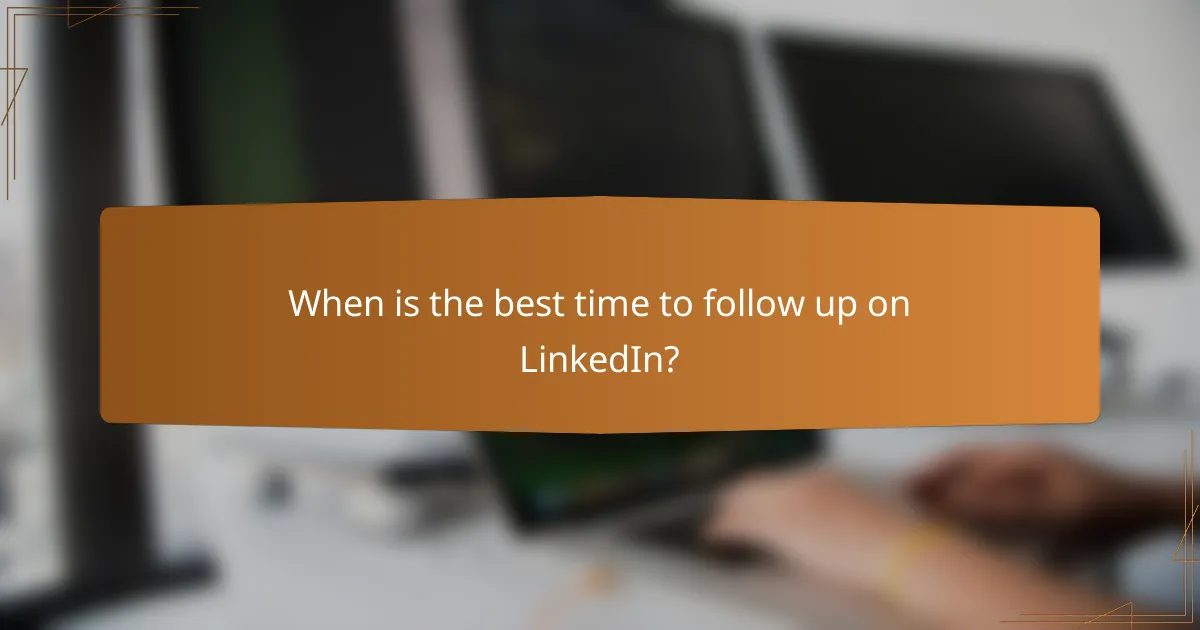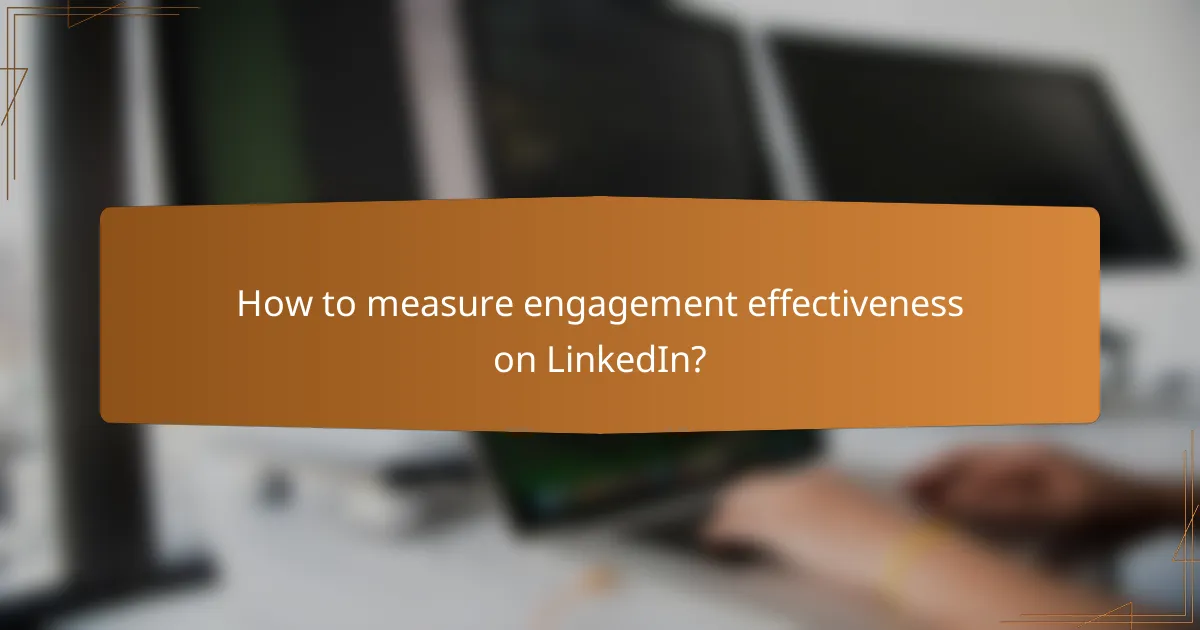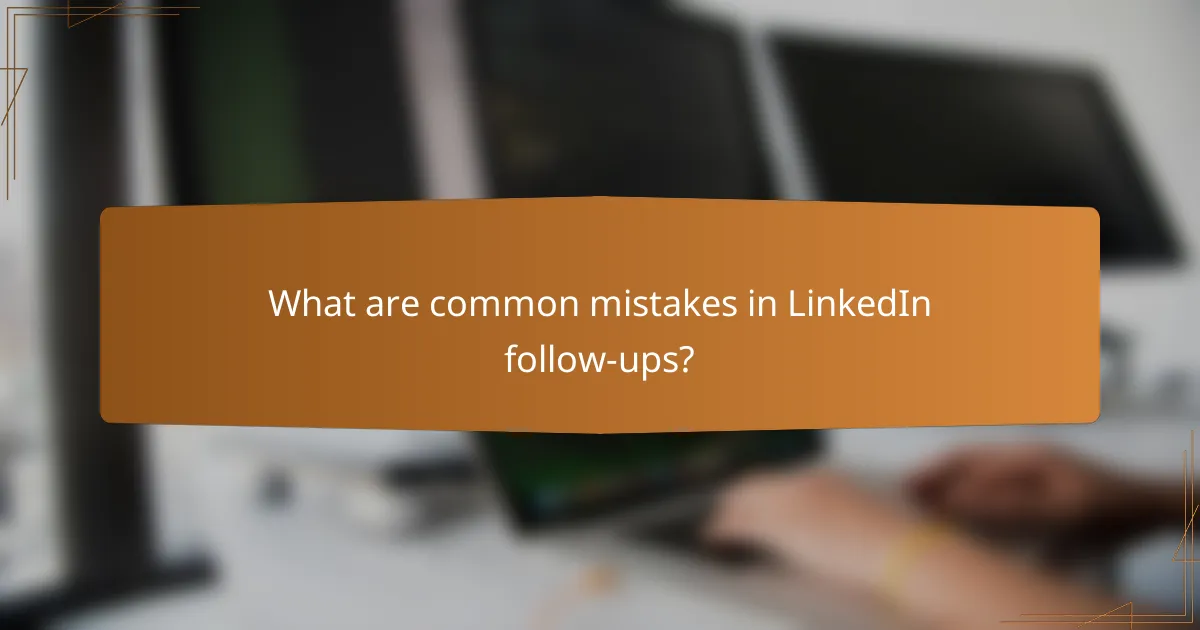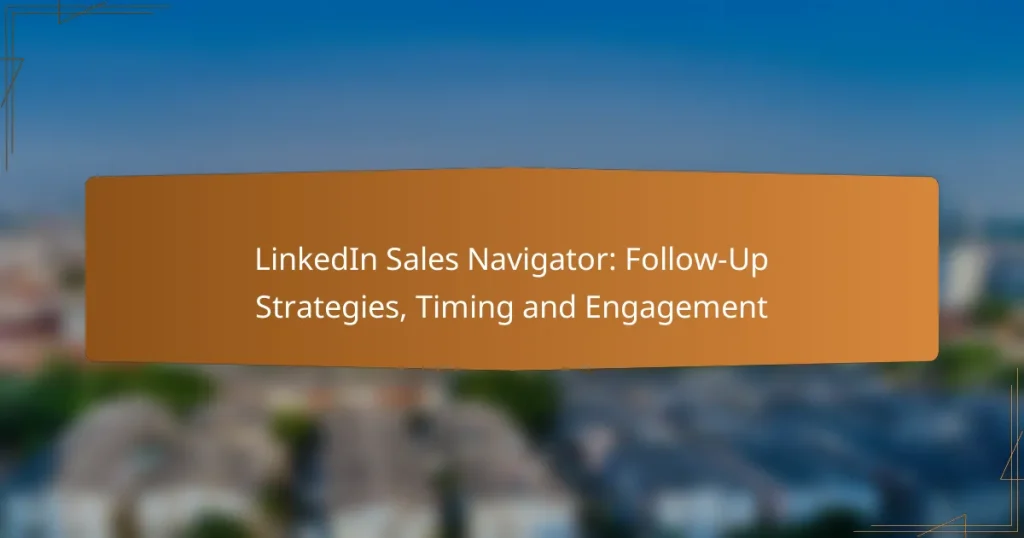Mastering follow-up strategies in LinkedIn Sales Navigator is crucial for nurturing relationships and enhancing engagement with prospects. By personalizing your communication and timing your follow-ups within 24 to 48 hours, you can keep conversations relevant and top-of-mind. Additionally, tracking engagement metrics such as response rates and connection growth will help you refine your approach and measure the effectiveness of your interactions.

What are effective follow-up strategies in LinkedIn Sales Navigator?
Effective follow-up strategies in LinkedIn Sales Navigator involve personalized communication, timely reminders, and active engagement with prospects. These approaches help maintain connections and increase the likelihood of successful interactions.
Personalized messaging
Personalized messaging is crucial for effective follow-ups. Tailor your messages to reflect the recipient’s interests, recent activities, or mutual connections. This not only shows that you value their time but also increases the chances of a response.
For example, referencing a recent post they made or a common interest can make your message stand out. Aim for a conversational tone while keeping it professional.
Utilizing connection reminders
Connection reminders in LinkedIn Sales Navigator help you keep track of when to follow up with your contacts. These reminders can be set based on specific intervals, such as one week or one month after your initial outreach.
Utilizing this feature ensures that you don’t miss opportunities to reconnect. Regular follow-ups can lead to stronger relationships and potential business opportunities.
Engaging with shared content
Engaging with content shared by your connections is an effective way to stay on their radar. Like, comment, or share their posts to demonstrate your interest and support.
This interaction can lead to organic conversations and provide a natural segue into follow-up discussions. Aim to add value to the conversation rather than simply promoting your agenda.
Setting follow-up tasks
Setting follow-up tasks within LinkedIn Sales Navigator helps you stay organized and proactive. Create tasks for each connection based on your interactions and their responses.
For instance, if a prospect expresses interest but doesn’t commit, set a task to follow up in a few weeks. This structured approach ensures you remain engaged without overwhelming your contacts.
Leveraging InMail for outreach
InMail is a powerful tool for outreach, especially when connecting with prospects outside your network. Use InMail to send personalized messages that highlight mutual interests or relevant insights.
Keep your InMail concise and focused, as recipients are more likely to respond to clear and direct communication. Aim for a response rate of around 20-25% by crafting compelling subject lines and opening statements.

When is the best time to follow up on LinkedIn?
The best time to follow up on LinkedIn is typically within 24 to 48 hours after your initial outreach. This timeframe keeps the conversation fresh in the recipient’s mind while allowing them enough time to respond thoughtfully.
Optimal days for engagement
Research indicates that mid-week days, particularly Tuesday through Thursday, are the most effective for engagement on LinkedIn. On these days, professionals are generally more active and open to networking opportunities.
Avoid Mondays, as many are catching up on tasks from the weekend, and Fridays, when attention often shifts to weekend plans. Instead, focus your follow-ups on the middle of the week for better response rates.
Best times of day for messaging
The ideal times to send messages on LinkedIn are during business hours, specifically between 10 AM and 12 PM, and again from 2 PM to 4 PM. These windows align with typical work schedules when users are most likely to check their messages.
Steer clear of early mornings and late afternoons, as many professionals may be less engaged during these times. Sending messages during lunch hours can also be hit or miss, as people may be away from their desks.
Timing based on user activity
Understanding the activity patterns of your target audience can significantly enhance your follow-up strategy. Monitor when your connections are most active on LinkedIn, which can often be inferred from their posting and engagement habits.
Utilize LinkedIn’s analytics tools to track engagement on your posts and messages. If you notice a particular connection is active during specific times, tailor your follow-ups to coincide with those periods for increased chances of a response.

How to measure engagement effectiveness on LinkedIn?
Measuring engagement effectiveness on LinkedIn involves tracking various metrics that reflect how well your interactions resonate with your audience. Key indicators include response rates, connection growth, and content interactions, which together provide a comprehensive view of your engagement strategy’s success.
Tracking response rates
Response rates indicate how many of your outreach efforts receive replies, helping you assess the effectiveness of your messaging. To track this, calculate the percentage of responses from your total outreach attempts. A typical response rate on LinkedIn can range from 10% to 30%, depending on your industry and approach.
To improve response rates, personalize your messages and ensure they are relevant to the recipient’s interests. Avoid generic templates, as tailored communication tends to yield better results.
Analyzing connection growth
Connection growth measures how quickly your network expands over time, reflecting your ability to engage potential leads. Monitor the number of new connections added weekly or monthly to gauge your outreach effectiveness. A steady growth rate of 5% to 10% per month is often considered healthy.
To enhance connection growth, actively engage with your existing network by commenting on their posts and sharing valuable content. This can encourage more people to connect with you and expand your reach.
Monitoring content interactions
Content interactions include likes, comments, and shares on your posts, serving as indicators of how well your content resonates with your audience. Track these interactions to identify which topics generate the most engagement. Aim for a minimum interaction rate of 2% to 5% for effective content.
To boost content interactions, focus on creating high-quality, relevant posts that encourage discussion. Utilize visuals and ask questions to prompt responses, making your content more engaging and shareable.

What are common mistakes in LinkedIn follow-ups?
Common mistakes in LinkedIn follow-ups can hinder your engagement and connection-building efforts. Avoiding these pitfalls can significantly enhance your chances of a positive response.
Overly generic messages
Sending overly generic messages is a frequent error that can lead to disengagement. Tailoring your follow-up to address specific interests or needs of the recipient shows that you value their time and perspective.
For example, instead of saying “I would love to connect,” you might say, “I noticed your expertise in digital marketing; I’d appreciate your insights on recent trends.” This approach fosters a more meaningful interaction.
Ignoring recipient’s profile
Failing to consider the recipient’s profile can result in missed opportunities for connection. Take the time to review their background, interests, and recent activity before crafting your message.
For instance, if they recently shared an article about industry challenges, referencing that article in your follow-up can demonstrate your attentiveness and relevance, making your message more impactful.
Failing to follow up consistently
Inconsistent follow-ups can lead to lost connections and missed opportunities. Establish a routine for following up, whether it’s weekly or bi-weekly, to maintain engagement without overwhelming the recipient.
A simple checklist can help: send an initial message, wait a week, then follow up with a relevant question or insight. This structured approach keeps the conversation alive and shows your commitment to building the relationship.

What criteria should be considered for follow-up messaging?
Effective follow-up messaging requires careful consideration of several criteria to enhance engagement and response rates. Key factors include the recipient’s engagement level, the history of previous interactions, and any industry-specific nuances that may influence communication style and timing.
Recipient’s engagement level
The recipient’s engagement level is crucial in determining how and when to follow up. If they have shown high interest, such as responding to previous messages or engaging with your content, a prompt follow-up can capitalize on their enthusiasm. Conversely, if their engagement has been minimal, a more cautious approach may be warranted.
To gauge engagement, consider tracking metrics like message open rates or responses. For example, if a recipient has opened your message multiple times but hasn’t replied, it may be beneficial to send a follow-up that addresses potential objections or questions they might have.
Previous interactions history
Understanding the history of previous interactions can guide your follow-up strategy. Review past communications to identify what topics resonated with the recipient or if there were any unresolved issues. This context allows you to tailor your follow-up message effectively.
For instance, if a recipient previously expressed interest in a specific product or service, referencing that in your follow-up can create a more personalized experience. Keep track of the timing of past communications as well; following up too soon or too late can affect the recipient’s perception of your professionalism.
Industry-specific nuances
Different industries have unique communication styles and expectations that should be considered in follow-up messaging. For example, tech industries may favor concise, data-driven messages, while creative industries might appreciate a more informal and personable approach.
Additionally, be aware of any seasonal trends or industry events that could impact timing. For instance, following up during a major industry conference may yield different results than reaching out during a quieter period. Tailoring your message to reflect these nuances can significantly improve engagement rates.

